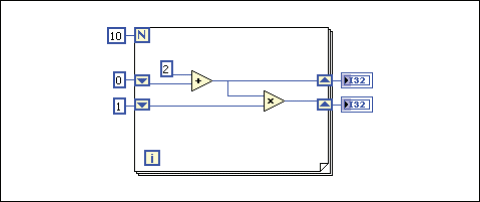

The first time you run the VI, the shift register begins with a value of 0, which is the default value for a 32-bit integer. In Figure 3, the For Loop executes five times, incrementing the value the shift register carries by one each time. Use an uninitialized shift register to preserve state information between subsequent executions of a VI. If you do not initialize the shift register, the loop uses the value written to the shift register when the loop last executed or, if the loop has never executed, the default value for the data type. Each time you run the VI, the shift register begins with a value of 0. After five iterations of the For Loop, the shift register passes the final value, 5, to the indicator and the VI quits. In Figure 2, the For Loop executes five times, incrementing the value the shift register carries by one each time. Initialize a shift register by wiring a control or constant to the shift register terminal on the left side of the loop, as shown in Figure 2. Initializing a shift register resets the value the shift register passes to the first iteration of the loop when the VI runs. If you have multiple operations that use previous iteration values within your loop, use multiple shift registers to store the data values from those different processes in the structure, as shown in Figure 1. You can add more than one shift register to a loop. The data you wire to the terminals of each shift register must be the same type. After the loop executes, the terminal on the right side of the loop returns the last value stored in the shift register.Ĭreate a shift register by right-clicking the left or right border of a loop and selecting Add Shift Register from the shortcut menu.Ī shift register transfers any data type and automatically changes to the data type of the first object wired to the shift register. LabVIEW transfers the data connected to the right side of the register to the next iteration. The terminal on the right side of the loop contains an up arrow and stores data on the completion of an iteration.

A shift register appears as a pair of terminals directly opposite each other on the vertical sides of the loop border. Use shift registers when you want to pass values from previous iterations through the loop to the next iteration.


 0 kommentar(er)
0 kommentar(er)
